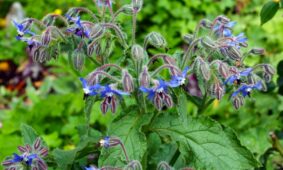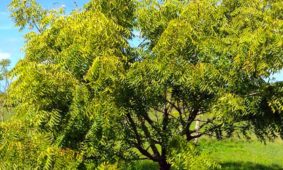Stevia the Sweet Herb
The Guarani Indians of Paraguay and Brazil had been sweetening their bitter beverages with kaa he-he (meaning sweet herb) for centuries before Italian botanist Moises Santiago Bertoni “discovered” the herb in 1887 and recognized it as a previously “unknown” variety of stevia. He named it Stevia rebaudiana in honor of the Paraguayan chemist named Rebaudi, […]
READ ARTICLEThe Borage Plant
Borago officinalis The Borage plant is an annual with an exquisite, bright blue and star-like flowers which are edible.The Borage flowers have very prominent black anthers that grow from its center. It grows to about 1 to 3 feet tall with multiple branches, hollow stems, and large, gray-green, oval, pointed leaves that are hairy. The […]
READ ARTICLEThe Gardens of Babylon
Many new devices, ideas and civilizations have emerged because, “Necessity is the mother of invention”. The shortage of water and available arable land for planting crops is not a new issue. Throughout history, archaeological evidence shows us that thousands of cities have been built on land that was safe from invasion, but not necessarily ideal […]
READ ARTICLEHydroponics First Recorded Scientific Experiments
Some three centuries ago, john Woodward, an English scientist and a fellow of the Royal Society, undertook the first recorded scientific experiments on the subject of plant nutrition. He wanted to know whether plants drew nourishment from the soil or from water. Woodward discovered that adding small amounts of soil to the water in which […]
READ ARTICLEOrganic Farming vs Hydroponics
“Go organic” has become the battle-cry of thousands of Americans who assume that food items labeled “organic” is automatically a better, healthier product. Is this really true? Both organic farming and hydroponic farming embrace a desire to protect our planet’s fragile environment. Both methods steer clear of harmful chemical fertilizers and pesticides. Both seek to […]
READ ARTICLEGreen ‘Lynx’ Spider
The Green ‘Lynx’ Spider is found on all kinds of shrub-like plants throughout the southern United States, Mexico, Central America, Venezuela and the West Indies. You can find the Green ‘Lynx’ Spider in woods on tall grasses and in meadows of tall wildflowers, especially on the heads of wild buckwheat. The Green ‘Lynx’ Spider is a common resident in Texas
READ ARTICLEWhat is Hydroponics?
Hydroponics basically means working water, “hydro” means “water” and “ponics” means “labor”. Believe it or not, Hydroponics has been around for thousands of years. The ancient Romans used it, and even the Babylonians used it in their ‘Hanging Gardens of Babylon‘. Additionally, ancient Egyptian hieroglyphics, dated several hundred years B.C. describe how they had grown […]
READ ARTICLEThe Neem Tree: A Miracle Plant
History Neem is a tropical evergreen tree native to the Indian sub-continent. This tree has a history of growing up to 50 ft. high and has been used for many different purposes for more than 4500 years. The earliest documentation revealed usage of various parts of Neem tree like fruit, leaves, seed oil, roots and […]
READ ARTICLECoco Coir
Coconut coir is a widely available growing medium that is becoming quite popular. Coconut coir is made from the husk of the coconut, which is often considered a byproduct when coconut is used in other industries. Coconut husk is processed to produce fibrous material for use as a growing medium, and is noted for its […]
READ ARTICLE
















